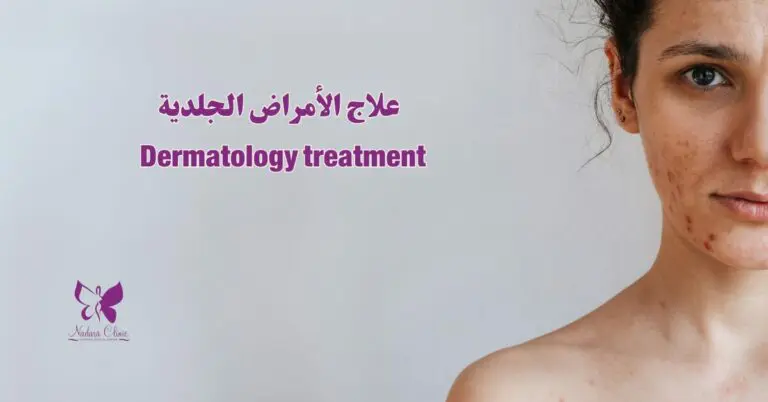Melasma is caused by an overproduction of the cells that make up your skin tone.
Women get 15% to 50% during their childbearing years.
It usually begins between the ages of 20 and 40 but rarely occurs during puberty.
In this article, we will discuss the causes of melasma during pregnancy, and what are its symptoms? and risk factors for infection.
We will also learn about ways to prevent infection, and how to treat it in a correct manner at the Freshness Center for Dermatology, Cosmetic and Laser in Hurghada.
What is the cost of pregnancy?
Melasma is defined as a skin condition characterized by brown, gray or blue patches.
Often called the "mask of pregnancy", this condition is very common during pregnancy.
The spots appear on the skin in a flat shape or may resemble freckles.
Melasma can affect any part of your skin. Affected areas of the face include the cheeks, upper lip, and forehead.
The spots may also appear on the forearms, arms, neck and back. They usually lessen over time, but often get worse in summer and improve in winter.
Causes of pregnancy melasma?
We should know before the causes of infection, what happens in the skin to show the color of the skin.
The skin consists of three layers:
- The outer layer is the epidermis.
- The middle is the dermis.
- The deepest layer is the subcutaneous layer.
The skin is the largest organ in the human body, accounting for about one seventh of the body's weight.
It is the barrier that protects muscles, bones, and organs from cold, germs, sunlight, moisture, injuries, toxic substances, and more.
It also helps in regulating body temperature, and makes you feel different sensations such as warmth and cold.
The epidermis contains cells called melanocytes that store and produce a dark color called pigment, known as melanin.
It occurs in response to light, heat, ultraviolet radiation, or through hormonal stimulation.
Melanocytes produce more melanin, which is why your skin will darken.
Pregnant women develop melasma as a result of exposure to radiation or harmful ultraviolet or infrared rays, or because of increased levels of the hormones estrogen and progesterone.
You can also read : Microneedling sessions for the skin and its benefits.
Symptoms of melasma during pregnancy
The main symptom of melasma is darkening of the facial skin. You may notice dark patches of different color on the forehead, cheeks, chin, or around the mouth.
These areas may get worse as you're exposed to the sun or as you advance in your pregnancy.
Melasma begins at any stage of pregnancy, although it most commonly appears in the second or third trimester.
What are the types of costs?
There are three types of melasma that are related to the depth of pigments, and the light detector can be used to determine the depth of the three types, and they include the following:
freckle skin
The spots appear dark brown, have well-defined borders, are visible under light, and are highly responsive to treatment.
Skin melasma
The skin is light brown or blue, contains melanophage (cells that ingest melanin) and has blurry edges.
It does not appear differently under light and does not respond well to treatment.
Mixed melasma
This type is more common than the others, has both blue and brown spots, shows a mixed pattern under light, and shows some response to treatment.
You can also read : White and red stretch marks and the difference between them.
Infection risk factors
Anyone can get it, but people with fair skin are less likely than those with dark brown skin.
Women are affected more often than men, with only about 10% for men and 90% for men and 90%.
Pregnant women get more melasma than anyone else.
Other risk factors for infection include:
Taking anti-seizure medications
Medications that prevent you from having seizures may be a cause of melasma, such as Clobazam.
Treatments used for birth control
If you take oral contraceptives and hormones (post-pregnancy) you are also at high risk.
Genetic factors
If one family member has melasma, there may be a risk of developing it for everyone else, and most identical twins also have a higher incidence than others.
Hypothyroidism
It is a condition in which thyroid hormones are less secreted, which helps the appearance of spots on your skin as a result of hormonal imbalance.
Too much staring at screens
Melasma may be caused by looking a lot at a television screen, computer, or cell phone.
Some beauty products
The use of some types of cosmetics may cause the appearance of melasma as a result of reactions called phototoxicity.
And there are skin care products that may make melasma worse than it is.
Therefore, do not use any cosmetic products or creams without consulting a dermatologist at the Freshness Center in Hurghada.
the age
Melasma can appear in people over 50 years of age or older.
photosensitive drugs
Certain types of nonsteroidal antibiotics include NSAIDs, diuretics, retinoids, diabetes medications, andantipsychoticsand some other treatments.
soap
Some scented soaps are thought to cause melasma to appear on your skin.
Tanning Products
The UV light that tanners produce is just as damaging to your skin as UV light from the sun, and sometimes it's even worse.
You can also read : Deep skin cleansing.
Diagnosis of pregnancy cost
The dermatologist at the Freshness Center for Dermatology, Cosmetology and Laser in Hurghada examines the skin thoroughly to diagnose melasma.
Melasma can sometimes be confused with another skin condition.
To tell the difference between skin conditions, your doctor may take a biopsy, where a small piece of skin can be removed for examination.
Skin conditions that can be confused with melasma include:
- Actinic lichen planus andlichen planus.
- Pigmentation as a result of drug addiction.
- Post-inflammatory pigmentation.
If you have melasma, your biopsy results will usually show:
- ramified (branching) melanocytes.
- Melanin in basal and supranasal keratinocytes.
- Presence of melanin in the dermis layer.
- Flexible fibres.
The severity of melasma can be measured using the MASI severity index.
Ways to prevent pregnancy melasma
If you develop melasma during pregnancy, be sure to avoid the following:
- Hormonal treatments, especially those that contain estrogen.
- Medications that increase or exacerbate melasma.
- Perfumed soap.
- Skin care products that cause irritation.
- tanning products.
- Computer and mobile screens.
- Exposure to sunlight to prevent symptoms from getting worse.
You can also read : Filler to treat dark circles.
Pregnancy and treatment costs
You can visit a dermatologist at Nadara Dermatology, Cosmetic and Laser Center in Hurghada to determine the appropriate treatment.
If you are in the sun, you can apply sunscreen containing iron oxide and SPF 30-50 every two hours.
Your doctor may prescribe some topical medications that block the formation of new pigments using tyrosinase inhibitors by stopping the formation of melanin.
Examples of these inhibitory medications and other effective treatments include:
Azelaic acid
This cream or gel is applied twice a day and is completely safe for pregnant women to use.
Cysteamine
Studies have proven that the use of this cream is highly effective in eliminating pregnancy costs.
hydrocortisone (topical corticosteroid)
This treatment helps fade discoloration caused by melasma and also reduces the possibility of dermatitis caused by other factors.
Hydroquinone
This medication can be applied as a cream or lotion, and is used for two to four months.
Methimazole
It is an anti-thyroid medication, available in the form of a cream or oral tablets, and helps treat melasma that is resistant to hydroquinone.
Tranexamic acid
It comes in the form of a cream, injection, or oral medication.
Other medications that can improve melasma include:
- Vitamin C.
- Arbutin.
- Glutathione.
- Kojic acid.
- Mequinol.
- Zinc sulphate.
How long medications take to take effect depends on the degree of melasma, the person's condition, and the type of medication used.
And melasma may be slow to respond to treatment, so there are some other treatment procedures that a dermatologist at Nadhara Center can do to improve melasma, such as:
peeling
There are many types of chemical peels that are suitable for all skin types, but the appropriate type of peel can be selected according to your doctor's instructions.
The doctor applies an exfoliating substance such as alpha hydroxy acids that works to exfoliate the skin, which renews it and makes it smoother.
30% to 70% glycolic acid peels which are very popular can be used for treatment.
Read also: Cellulite | Causes and ways to get rid of it.
laser treatment for melasma
The laser can also be used to get rid of melasma permanently, and the types used include the following:
Fractional laser
This type of laser cuts holes in the skin to stimulate the growth of new, healthy skin cells.
The beam of light can be segmented into small light columns, each providing a strong, highly focused energy.
These columns penetrate the skin in the same way that a fine-needle tool affects the skin.
The laser energy is focused to create tiny channels through the skin, then the heat is absorbed by the underlying support tissues.
This energy causes the collagen to contract, which stimulates the body to produce more of this substance.
There may be a tingling sensation, but a local anesthetic is usually applied before the procedure.
Skin looks immediately red, or discolored, and rough afterwards, but after about 3 to 5 days of recovery, it will look brighter and more even.
You can get full results in 3 to 6 months, and you may need 3 to 4 sessions at least 1 month apart.
Avoid exposure to the sun during the recovery process, and use a high protection sunscreen.
Your dermatologist may also recommend continuing to use a skin-lightening treatment after the laser.
excimer laser
This type of laser emits rays to stimulate and stimulate the growth of new cells, and this happens without penetrating the deeper layers of the skin.
Ultraviolet rays with a large wavelength can be used to give the desired results.
One session takes a few seconds, and you may need up to 20 sessions in a maximum of 3 months.
It is one of the safe types of laser that may be used during pregnancy as well as breastfeeding.
You can also read : Tine versicolor and its treatment.
Frequently asked questions about pregnancy costs
Is melasma a symptom of skin cancer?
Melasma is not cancerous, or a sign of cancer, yet there are skin cancers It may be associated with the presence of melasma.
Therefore, a dermatologist should be consulted at the Freshness Center for Dermatology, Aesthetics and Laser in Hurghada to confirm the correct diagnosis.
Does pregnancy cost go away after childbirth?
Melasma is a typical chronic disorder, meaning it is long-term (three months or more), and some people have it for years or even their life.
But it disappears shortly after birth and does not last long.
Pregnant women or breastfeeding mothers may need to wait a while for melasma to treat.
Many creams should be discontinued due to the potential risks to the developing fetus and newborn.
Is melasma painful?
Melasma does not cause any harm or pain, and is not itchy or uncomfortable in any way.
Do certain foods contribute to the emergence of pregnancy melasma?
There are no proven studies that eating any foods or drinks directly cause melasma, magically treat it, or make it worse.
But to maintain your skin, you should follow a healthy skin diet by eating foods rich in vitamin D, such as the following:
- Almond milk.
- eggs.
- meat.
- dairy.
- fish.
- orange juice.
- Yogurt.
Is laser treatment effective for melasma? Is it safe during pregnancy?
Lasers can be used to treat melasma, but they should be used with caution during pregnancy, and treatments are most effective when repeated.
Is there a relationship between the appearance of melasma and the sex of the fetus?
Some people believed that there was a relationship between melasma and determining the sex of the newborn due to the difference in the level of hormones.
But in fact, the level of hormones is the same when pregnant, male or female.
Therefore, there is no clear relationship between melasma and the gender of the newborn.
In conclusion, pregnancy cost is a very common problem during this period, but it goes away on its own, or by using one of the different treatment methods such as peeling, topical medications, or using a laser.
You can consult a dermatologist at the Freshness Center for Dermatology, Cosmetic and Laser in Hurghada, Red Sea Governorate, to find out the appropriate treatment for pregnancy costs.







